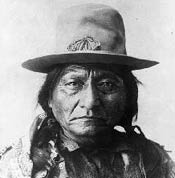Tatanka-Iyotanka (1831-1890)

Sitting Bull is a name in history most people can recall. He was a leader and holy man of the Hunkpapa Lakota (Hunkpapa, one of the seven bands of the Lakota/Sioux).
At the time the threat of white Europeans encroaching on land that had quietly supported the Lakota for centuries was great. Passive resistance had proven futile and treaties had been shown to be a string of government promises broken. For these reasons, Sitting Bull was instrumental in leading his people in acts of defense to preserve their way of life on the northern plains of the U.S. territories.
He remained committed to his position against the U.S. military and the lies and promises of the U.S. government through his dying day.
It is believed Sitting Bull was born along the banks of the Grand River in Dakota Territory. He was politically inclined early, as a leader of a warrior society and also as a member of a brotherhood dedicated to tribal welfare.
It was just a matter of time before Sitting Bull was at war with U.S. soldiers. His first altercation came in June of 1863 in defense of the army, which set out to suppress all plains people in response to a Santee Dakota uprising in Minnesota. One battle seemed to follow another, and by 1868 Sitting Bull’s capacity for bravery and strategy brought him to the head of the Lakota nation.
The Black Hills of South Dakota are sacred lands to the Lakota, so when a mine survey expedition led by George Armstrong Custer in 1974 announced there was gold in the Black Hills there was bound to be trouble because the Fort Laramie Treaty of 1868 had guaranteed the preservation of the land and banned white settlement in the area. Custer’s announcement brought prospectors in droves, breaking the treaty and forcing the Lakota to defend what the government itself had deemed theirs. To try to remedy the problem, the government, illustrating a total lack of understanding of the Indian belief system, offered to buy the Black Hills. When that failed, all Lakota were ordered onto reservations by the end of 1876 or be considered “hostile Indians.” Sitting Bull and his people had no intention of leaving.
The year that followed saw many battles. During ceremony before one battle, Sitting Bull had a vision that showed soldiers falling into his camp like grasshoppers falling from the sky. Later, Sitting Bull was joined by Crazy Horse and his band of Lakota, Cheyenne and Arapaho – 3000 warriors in all, so when Custer attacked the camp at Little Big Horn he was badly outnumbered and his soldiers fell much like Sitting Bull had envisioned.
The army’s defeat only lead to a greater army presence, and they chased the Lakota relentlessly for the next year. Many chiefs surrendered, but Sitting Bull remained defiant. In May 1877 he led his band across the border into Canada, beyond the reach of the army, and when General Terry traveled north to offer him a pardon in exchange for settling on a reservation, Sitting Bull defiantly sent him away. Within four years however, with buffalo long gone, Sitting Bull returned and surrendered. None of his simple requests were honored, and he was sent to Standing Rock Reservation where it was felt he could be contained and kept from prompting any further uprisings. Still not secure, the government sent him to Fort Randall on the Missouri River where he was held as a prisoner of war. Moved back to Standing Rock, he was chided and tormented by the agent in charge, but not deterred.
Sitting Bull was allowed to leave the reservation in 1885 to join Buffalo Bill’s Wild West Show, but remained with the troupe only four months because he could not stand such intense proximity to white society. Back at Standing Rock, Sitting Bull lived in a cabin on the Grand River, near where he had been born. He refused to give up his old ways as the reservation rules required, continuing to live with nis two wives and rejecting Christianity, though he sent his children to a nearby Christian school in the belief that the next generation of Lakota would need to be able to read and write.
Soon after his return, Sitting Bull had another mystical vision, like the one that had foretold Custer’s defeat. This time he saw a meadowlark alight on a hillock beside him, and heard it say, “Your own people, Lakotas, will kill you.” Nearly five years later, this vision also proved true. Word was traveling fast through the plains of the Ghost Dance, which would rid the area of whites forever. In 1890, fearful that Sitting Bull, still considered a leader of his people, would join the Ghost Dance movement, Lakota police who worked for the agent were sent to arrest him. As followers gathered to protect Sitting Bull, a gunfight began and a member of the Lakota police shot Sitting Bull in the head. He was buried at Fort Yates, North Dakota but in 1953 his remains were moved to Mobridge, South Dakota.
He is remembered among the Lakota as many things, including inspirational leader, courageous warrior, loving father, gifted singer and warm friend to many, whose spirituality provided him prophetic insight and lent special power to his prayers.






